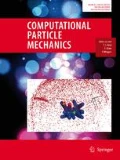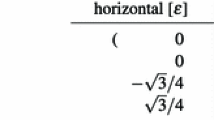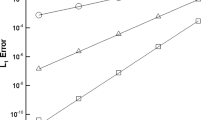Abstract
A strategy is introduced to allow coupling of the material point method (MPM) and smoothed particle hydrodynamics (SPH) for numerical simulations. This new strategy partitions the domain into SPH and MPM regions, particles carry all state variables and as such no special treatment is required for the transition between regions. The aim of this work is to derive and validate the coupling methodology between MPM and SPH. Such coupling allows for general boundary conditions to be used in an SPH simulation without further augmentation. Additionally, as SPH is a purely particle method, and MPM is a combination of particles and a mesh. This coupling also permits a smooth transition from particle methods to mesh methods, where further coupling to mesh methods could in future provide an effective farfield boundary treatment for the SPH method. The coupling technique is introduced and described alongside a number of simulations in 1D and 2D to validate and contextualize the potential of using these two methods in a single simulation. The strategy shown here is capable of fully coupling the two methods without any complicated algorithms to transform information from one method to another.














Similar content being viewed by others
References
Cleary PW, Prakash M, Ha J (2006) Novel applications of smoothed particle hydrodynamics (SPH) in metal forming. J Mater Process Technol 177(1–3):41–48
Cleary PW, Savage G, Ha J, Prakash M (2014) Flow analysis and validation of numerical modelling for a thin walled high pressure die casting using SPH. Comput Part Mech 1(3):229–243
Sulsky D, Chen Z, Schreyer HL (1994) A particle method for history-dependent materials. Comput Methods Appl Mech Eng 118:179–196
Raymond S, Aimene YE, Nairn J, Ouenes A (2015) Coupled fluid-solid geomechanical modeling of multiple hydraulic fractures interacting with natural fractures and the resulting proppant modeling proppant distribution in the presence of natural fractures using the material point method ( MPM ). In: SPE unconventional resources conference
Gray JP, Monaghan JJ, Swift RP (2001) SPH elastic dynamics. Comput Methods Appl Mech Eng 190(49–50):6641–6662
Benz W, Asphaug E (1995) Simulations of brittle solids using smooth particle hydrodynamics. Comput Phys Commun 87:253–265
Douillet-grellier T, Pramanik R, Pan K, Albaiz A, Jones BD, Williams JR (2016) Development of stress boundary conditions in smoothed particle hydrodynamics (SPH) for the modeling of solids deformation. Comput Part Mech 1–28
Raymond S, Lemiale V, Ibrahim R, Lau R (2014) A meshfree study of the KalthoffWinkler experiment in 3D at room and low temperatures under dynamic loading using viscoplastic modelling. Eng Anal Bound Elem 42:20–25
Das R, Cleary PW (2010) Effect of rock shapes on brittle fracture using smoothed particle hydrodynamics. Theor Appl Fract Mech 53(1):47–60
Monaghan Joseph J (2005) Smoothed particle hydrodynamics. Rep Prog Phys 68(8):1703–1759
Kajtar JB, Monaghan JJ (2010) On the dynamics of swimming linked bodies. Eur J Mech B/Fluids 29(5):377–386
Cleary PW, Sinnott MD, Hari B, Bakalis S, Harrison SM (2015) Modelling food digestion. Elsevier, London
Violeau D (2012) Fluid mechanics and the SPH method. Oxford Press, Oxford
Canelas R, Ferreira RML, Crespo AJC, Dominguez JM (2013) A generalized SPH-DEM discretization for the modelling of complex multiphasic free surface flows. In: Proceedings of the 8th International SPHERIC Workshop (June 4–6), p 6
Chuzel-Marmot Y, Ortiz R, Combescure A (2011) Three dimensional SPH-FEM gluing for simulation of fast impacts on concrete slabs. Comput Struct 89(23–24):2484–2494
Cleary PW (2015) Prediction of coupled particle and fluid flows using DEM and SPH. Miner Eng 73:85–99
Fernandez JW, Cleary PW, Sinnott MD, Morrison RD (2011) Using SPH one-way coupled to DEM to model wet industrial banana screens. Miner Eng 24(8):741–753
Hu D, Long T, Xiao Y, Han X, Gu Y (2014) Fluid-structure interaction analysis by coupled FE-SPH model based on a novel searching algorithm. Comput Methods Appl Mech Eng 276:266–286
Huang YJ, Nydal OJ (2012) Coupling of discrete-element method and smoothed particle hydrodynamics for liquid-solid flows. Theor Appl Mech Lett 2:012002
Libersky LD, Petschek AG, Carney TC, Hipp JR, Allahdadi FA (1993) High Strain Lagrangian Hydrodynamics
Cleary PW (2010) Elastoplastic deformation during projectile-wall collision. Appl Math Model 34(2):266–283
Harlow FH, Amsden AA (1971) A numerical fluid dynamics calculation method for all flow speeds. J Comput Phys 8(2):197–213
Sulsky D, Zhou S, Schreyer HL (1995) Application of a particle-in-cell method to solid mechanics. Comput Phys Commun 87:236–252
Abe K, Soga K, Bandara S (2013) Material Point Method for Coupled Hydromechanical Problems. J Geotech 1–16
Abe K, Konagai K (2015) Numerical simulation of a series of flume tests with dry and wet sands by using depth averaged material point method. In: Geomechanics from micro to macro, pp 971–976
Lemiale V, Nairn J, Hurmane A (2010) Material point method simulation of equal channel angular pressing involving large plastic strain and contact through sharp corners. Comput Model Eng Sci 70(1):41–66
Sulsky D, Kaul A (2004) Implicit dynamics in the material-point method. Comput Methods Appl Mech Eng 193(12–14):1137–1170
Sulsky D, Schreyer H L, Peterson K, Kwok R, Coon M (2007) Using the material-point method to model sea ice dynamics. J Geophys Res Ocean 112(August 2006):1–18
Sulsky D, Peterson K (2011) Toward a new elastic-decohesive model of Arctic sea ice. Physica D 240(20):1674–1683
Nairn J (2003) Material point method calculations with explicit cracks. Comput Model Eng Sci 4(6):649–663
Bardenhagen SG, Brackbill JUJU, Sulsky D (2000) The material-point method for granular materials. Comput Methods Appl Mech Eng 187(99):529–541
Nairn JA (2015) Numerical Modeling of Orthogonal Cutting: Application to Woodworking with a Bench Plane 1–17
Bardenhagen SG, Kober EM (2004) The generalized interpolation material point method. Comput Model Eng Sci 5(6):477–495
Sadeghirad A, Brannon R, Burghardt J (2011) A convected particle domain interpolation technique to extend applicability of the material point method for problems involving massive deformations. Int J Numer Methods Eng 86(March):1435–1456
Sadeghirad A, Rebecca B, Guilkey JE (2013) Second-order convected particle domain interpolation (CPDI2) with enrichment for weak discontinuities at material interfaces. Int J Numer Methods Eng 95(July):928–952
Monaghan JJ (2005) Smoothed particle hydrodynamics. Rep Prog Phys 68(8):1703
Acknowledgements
The authors would like to thank the Abu Dhabi National Oil Company (ADNOC) for its scientific and financial support.
Author information
Authors and Affiliations
Corresponding author
Rights and permissions
About this article
Cite this article
Raymond, S.J., Jones, B. & Williams, J.R. A strategy to couple the material point method (MPM) and smoothed particle hydrodynamics (SPH) computational techniques. Comp. Part. Mech. 5, 49–58 (2018). https://doi.org/10.1007/s40571-016-0149-9
Received:
Revised:
Accepted:
Published:
Issue Date:
DOI: https://doi.org/10.1007/s40571-016-0149-9




